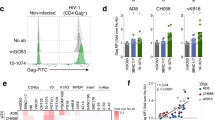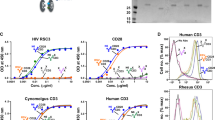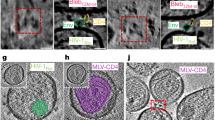Abstract
The T-cell surface glycoprotein, CD4 (T4), acts as the cellular receptor for human immunodeficiency virus, type 1 (HIV-1), the first member of the family of viruses that cause acquired immunodeficiency syndrome1–4. HIV recognition of CD4 is prob-ably mediated through the virus envelope glycoprotein (gp!20) as shown by co-immunoprecipitation of CD4 and gp!20 (ref. 5) and by experiments using recombinant gp!20 as a binding probe6. Here we demonstrate that recombinant soluble CD4 (rsT4) purified from the conditioned medium of a stably transfected Chinese hamster ovary cell line is a potent inhibitor of both virus replication and virus-induced cell fusion (syncytium formation). These results suggest that rsT4 is sufficient to bind HIV, and that it represents a potential anti-viral therapy for HIV infection.
This is a preview of subscription content, access via your institution
Access options
Subscribe to this journal
Receive 51 print issues and online access
$199.00 per year
only $3.90 per issue
Buy this article
- Purchase on Springer Link
- Instant access to full article PDF
Prices may be subject to local taxes which are calculated during checkout
Similar content being viewed by others
References
Dalgleish, A. G. et al. Nature 312, 763–767 (1984).
Klatzmann, D. et al. Nature 312, 767–768 (1984).
Maddon, P. J. et al. Cell 47, 333–348 (1986).
McDougal, J. S. et al. J. Immun. 135, 3151–3162 (1985).
McDougal, J. S. et al. Science 231, 382–385 (1986).
Lasky, L. A. et al. Cell 50, 975–985 (1987).
Wallner, B. et al. J. exp. Med. 166, 923–932 (1987).
Maddon, P. J. et al. Cell 42, 93–104 (1985).
Cate, R. L. et al. Cell 45, 685–698 (1986).
Kaufman, R. J. & Sharp, P. A. J. molec. Biol. 159, 601–621 (1982).
Haynes, J. & Weissmann, C. Nucleic Acids Res. 11, 687–706 (1983).
Rao, P. E., Talle, M. A., Rung, P. C. & Goldstein, G. Cell Immun. 80, 310–319 (1983).
Gething, M. J., McCammon, K. & Sambrook, J. Cell 46, 939–950 (1986).
Ho, D. et al. J. Virol. 61, 2024–2028 (1987).
Sodroski, J., Goh, W. C., Rosen, C., Campbell, K. & Haseltine, W. A. Nature 322, 470–474 (1986).
Lifson, J. D. et al. Nature 323, 725–728 (1986).
Swain, S. L. Immunol. Rev. 74, 129–142 (1983).
Kyte, J. & Doolittle, R. F. J. molec. Biol. 157, 105–132 (1982).
Benton, W. D. & Davis, R. W. Science 196, 180–182 (1977).
Maxam, A. M. & Gilbert, W. Meth. Enzym. 68, 499–580 (1980).
Acuto, O. et al. Cell 34, 717–726 (1983).
Sayre, P. H. & Reinherz, E. L. Eur. J. Immun. 15, 291–295 (1985).
Laemmli, U. K. Nature 227, 680–685 (1970).
Towbin, H., Staehelin, T. & Gordon, J. Proc. natn. Acad. Sci. U.S.A. 76, 4350–4354 (1979).
Pepinsky, R. B. et al. J. biol. Chem. 261, 4239–4246 (1986).
Hartshorn, K. L. Antimicrob. Agents Chemother. 31, 168–172 (1987).
Walker, B. D. et al. Proc. natn. Acad. Sci. U.S.A. 84, 8120–8124 (1987).
Author information
Authors and Affiliations
Rights and permissions
About this article
Cite this article
Fisher, R., Bertonis, J., Meier, W. et al. HIV infection is blocked in vitro by recombinant soluble CD4. Nature 331, 76–78 (1988). https://doi.org/10.1038/331076a0
Received:
Accepted:
Issue Date:
DOI: https://doi.org/10.1038/331076a0
This article is cited by
-
Distinct conformations of the HIV-1 V3 loop crown are targetable for broad neutralization
Nature Communications (2021)
-
MiniCD4 protein resistance mutations affect binding to the HIV-1 gp120 CD4 binding site and decrease entry efficiency
Retrovirology (2012)
-
Potent suppression of HIV-1 replication in humans by T-20, a peptide inhibitor of gp41-mediated virus entry
Nature Medicine (1998)
Comments
By submitting a comment you agree to abide by our Terms and Community Guidelines. If you find something abusive or that does not comply with our terms or guidelines please flag it as inappropriate.



